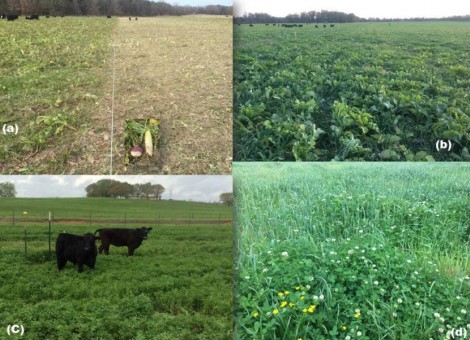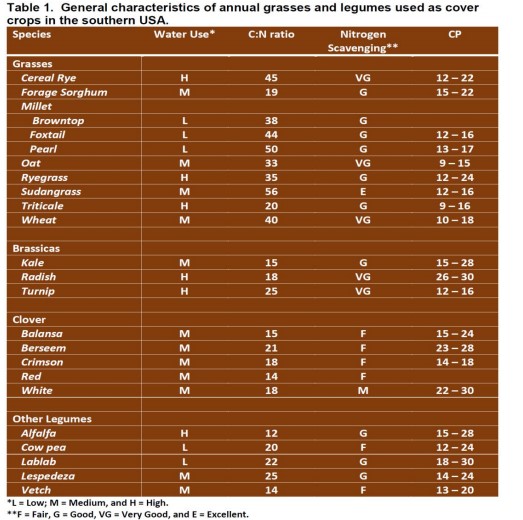Cover crops are usually annual forage crops that can be planted in the fall after a row crop (soybean, corn, or cotton) harvest or in the summer after a wheat harvest. These forage crops can provide multiple benefits such as reduce or prevent soil erosion, improve soil structure, increase organic matter, increase carbon sequestration, remove nutrients from deeper soil layers, reduce weed competition, and provide optimum forage biomass (provided good soil moisture) and high nutritive value for livestock grazing.
For producers wanted to transitioning from row crop production to grazing cover crops in the winter, there might be some restrictions. This is due to the herbicide residual or carry over from row production that may prevent using cover crops or crop residue in a specific field as livestock forage. Herbicide carryover may prevent successful establishment. A large number of herbicides used in row crop prohibit grazing or feeding forage, hay, or straw. Check your herbicide application records before establishing a cover crop for grazing. It is important to pay attention to the planting and grazing restrictions for the herbicides applied in row crop production.
There is a good number of forage species and mixes that can be used as cover crops and selection will depend on thecover crop system. For example, in a row crop rotation, early maturing species must be selected to allow termination of the forage production for establishing the subsequent row crop. On the other hand, in a grazing system, late maturing species must be selected to extend the grazing season and allow the transition into summer perennial pastures such as bermudagrass and bahiagrass. Often, since more cool-season cover crops are annual systems, a warmseason annual grass (millets, sorghum-sudan, and forage sorghum) can be used as part of the cover crop rotation during the summer.

When selecting forages as cover crop species, you should select species that are compatible in growth habit, water use, and growth cycle. Usually, a mixture or cocktail of 3 to 4 species will be ideal and sufficient to reach the intended use of grazing cover crops. Keep in mind that by increasing the number of species in the mixture, you will be reducing seeding rate and impacting establishment. A basic mixture should include at least a grass, a legume, and possibly a brassica. Some of the characteristics that are important in cove crops include C:N ratio, water use demand, and nitrogen removal. Cover crops could help with water retention by proving cover and reducing water evapotranspiration. Table 1 provides some general characteristics of cover crops that could be used in the southern USA. However, complex mixtures often cost more, maybe more difficult to establish, and would require more complex management practices. It is not clear how useful the multi-species cover crop mixtures (4 or more) are, or their potential impact on economics of production. When building a cover crop mixture always consider crops that could provide the following benefits: (1) soil builder, (2) can fix or scavenge nitrogen, (3) can prevent erosion, (4) can reduce water loss, and (5) can provide yield and quality to sustain grazing.

The benefits of cover crops is to scavenge or fix nutrients that could be used for the next row crop season. One issue is that most of the nutrients in the cover crops will be tied up into plant organic compounds that could be broken down by soil microbes. Rates of organic matter decomposition are related to soil temperature and moisture and could take several months for the process to occur. On the other hand, by grazing cover crops, microbial populations in the rumen can break those complex compounds in a shorter time through cycling and make them available to the soil in a shorter time.
This is due to that livestock can increase nutrient cycling (nitrogen, phosphorus and potassium) through urine and manure deposition.
Some row crop producers might worry about possible soil compaction while grazing cover crops. A six-year study at University of Georgia indicated that grazed soils with slightly higher bulk density than non-grazed treatments after six years while grazing cover crops led to greater soil penetration resistance. A study at University of Nebraska indicated that grazing cover crops could cause some soil compaction after several years of the treatment, but not within the first few years. This suggest that producers can benefit from grazing cover crops without significant adverse effects in soil properties and yield production; however, there could be site-specific soil compaction from grazing cover crops and each site should be evaluated in individual basis.
Many varieties of forage crops can be used as cover crops, each has a unique growth habit and rooting structure. There are three common cover crops groups: grasses, legumes, and brassicas. Forage grasses include annual cool-season
grasses [annual ryegrass and small grains (cereal rye, wheat, oat, and triticale)] and war-season annual grasses (forage sorghum, millets, and sudangrass). These plants could develop extensive fibrous roots that could help with scavenging nutrients, suppressing weeds, providing erosion control and adding organic matter. Legume forage crops such alfalfa and clovers (annual and perennial) can help fixing nitrogen from 40 to 120 lb N/ac depending on the forage species, soil pH, and climatic conditions. Brassicas are productive under soils ranging from 5.5 to 6.8 with good drainage. Brassicas (tops and bulb types) are very nutritious to livestock, their use and productivity can be affected by soil moisture and temperature. Some of the species include radishes, turnips, rape, kale, and swede. They can have up to 25% crude protein and up to 75% total digestible nutrients. The top type tend to be higher in protein while the bulb type tend to be highly digestible. In a grazing system, brassicas should not be more than 50 to 70% of the mix.
Several precautions should be taken in grazing certain cover crops. Pastures with high clover percentage (>40%) can have potential bloating in livestock. Brassicas have a nitrogen scavenging ability and they could have the tendency to accumulate nitrates under stress conditions. Some of the animal disorders cause by brassicas include: nitrate poisoning, bloat, hypothyroidism, bloat, hemolytic anemia and polioencephalomalicia. Adapt livestock gradually to grazing brassicas and do not turn them out hungry. Other forages, such as oats and millet can also contain high levels of nitrates if grown under dry conditions.
Cover crops can provide different benefits from the soil health point of view and they provide a window to integrate a Cover crops can provide different benefits from the soil health point of view while providing a window to integrate a complementary row crop and livestock system and help recover some of the expenses associated with growing cover crops. Although grazing cover crops provides an option for row crops systems in the winter months, there are some challenges that need to be met such as investment in seed, fence, water source, minerals, and equipment. It will also require some
more complex management skills with livestock handling, animal health, and purchasing livestock. The ideal cover crop species or mixture will depend on the specific management objectives of the producer. Unless nitrogen fixation is the
primary objective, choose the least expensive cover crop alternative. Contact your local Count Extension Office for more information related to cover crops and options that might be suitable to your area and help fine-tune your practices.